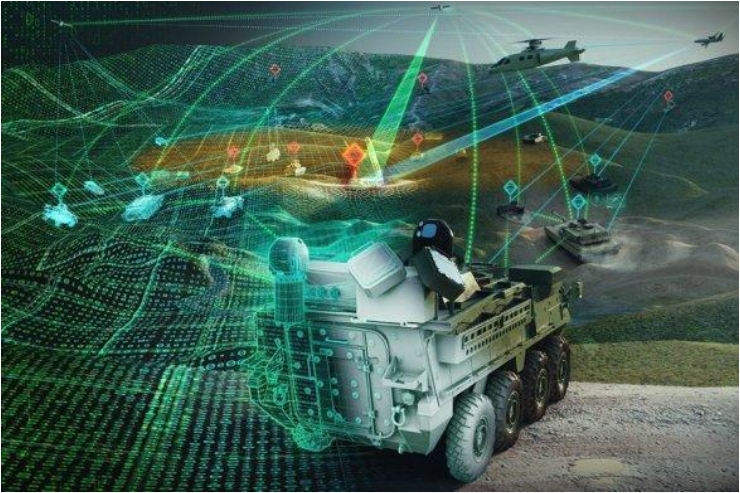



Satellites now sit at the heart of geopolitical power, playing a pivotal role in warfare and strategy. SpaceX’s Tranche 0 satellites for the U.S. military and Starlink’s impact in Ukraine exemplify this shift. Yet, amidst the dazzle of rocket launches and mega-constellations, a silent cyber battle is escalating.
This report explores the interconnected realms of SpaceX’s advancements, the rise of satellite networks, and the looming threat of cyber warfare in space. The U.S. military faces a double-edged sword: capitalizing on technological leaps like Starlink’s potential for military information fusion, while shielding against cyberattacks and electronic warfare.
China and Russia, formidable players in the space race, add complexity with their expertise in cyberwarfare. Jamming, spoofing, and silent attacks – akin to those disrupting Ukraine – highlight the subtle and potentially devastating arsenal employed in this new, deniable battleground.
Vulnerabilities are everywhere, from satellite design to operation. The U.S., heavily reliant on space for global reach, faces the stark reality: space, once a frontier, is now a potential Achilles’ heel.
The skies hold the promise of advanced communication and strategic advantage, but also harbor the potential for a silent war with global consequences. Navigating this precarious balance requires unraveling the tapestry of satellite technology, cyber threats, and the imperative for a secure and peaceful future in space.
This autumn, SpaceX’s Falcon 9 rocket carried 13 Tranche 0 satellites for the US military’s Space Development Agency (SDA). Tranche 0 is a new generation of reconnaissance, surveillance, intelligence and communications satellite for the future Proliferated Warfighter Space Architecture (PWSA) mega-constellation. It will be the key to the newly emerging US CJADC2 (Combined Joint All Domain Command and Control; formerly known as JDAC2) concept/ strategy.
The Starlink satellite network has fundamentally changed the course of the war in Ukraine, for the benefit of the defending nation. While we can safely posit there are no real ‘game changers‘ in modern warfighting, Starlink – or modern satellite mega constellations like Starlink – are the closest thing to it. The US Space Command clearly stated that the Ukraine war is demonstrating the future of military communications and the tremendous resilience and redundancy provided by satellite mega constellations. According to Space Command, the Starlink communications network in particular, has enabled the Ukrainian armed forces to maintain communications, becoming absolutely vital technology. Indeed, according to Ukraine’s military, Starlink has become the “lifeblood” of Ukraine’s communications infrastructure.
Starlink and its competitors could not have existed without the price revolution in rocket launches. SpaceX, with its Falcon 9 rockets, has heavily reduced the price of sending a load into orbit, (even in comparison to the Space Shuttle programme) and has additionally built a manufacturing, service and organizational ecosystem on a greenfield site, enabling it to significantly increase the cadence of rocket launches and effectively dominate the market.

The key metric is not the number of launches, but the weight of the payload, and here the numbers are clear: During the first quarter of this year, SpaceX carried 233 tonnes of cargo into orbit; China only 24 tonnes. In that period, SpaceX carried five times more cargo than Russia and China combined, and over the past year, SpaceX has carried twice as much cargo as the rest of the world combined.
To understand the gargantuan scale of achievement by SpaceX, it is necessary to understand their mastery of the development and production of very low-cost rockets, including the most powerful rocket of our time – ‘Falcon Heavy‘ – which was designed and built with highly efficient servicing facilities (e.g. minimalist launch pads) for high cadence launches. They have also mastered the mass production of satellites (hundreds of units per month), which further makes the Starlink satellite mega-constellation operational, and provides the possibility of globally available high-speed internet with dual (civilian and military) potential.
The potential of SpaceX and the possibilities of satellite mega-constellations was quickly grasped by the Pentagon. Moreover, military leaders at the US Department of Defense are impressed by SpaceX’s high degree of competitiveness and speed, factors which are arguably lost to the bureaucratic acquisition processes of large governements like the United States (and why, some may argue, that they are rapidly losing their military edge to China). “Speed” is now a key driver in the Pentagon, with the SDA created to expedite acquisition processes for space programs, their motto being “Semper Citius” (Always Faster).
The development of classic sophisticated and incredibly expensive US military satellites takes on an average seven years. The Air Force is pushing for the US Space Forces to move away from buying billions of dollars‘ worth of satellites to building smaller and expendable domestic satellites quickly. “Our competitors seem to have gone into overdrive. It’s time for us to do the same,” US officials stated, referring to China and its missile and cyber warfare programmes.
Through the SDA, the Pentagon intends to build mega-constellation PWSA satellite layers (Layers) very quickly in low Earth orbits. The various PWSA layers are tasked with tracking enemy missiles (Tracking Layer), tracking and targeting mobile ground targets in all weather (Custody Layer), communications (Transport Layer), navigation and precision timing (Navigation Layer), and command and control systems (Battle Management Layer).
The Transport Layer satellites are the backbone of the PWSA and carry the radio and optical communications systems, with the optical links forming the mesh topology. There is also a tactical Link 16 data link: tracking layer satellites act as a persistent wide-field infrared surveillance of Earth’s airspace, with the sole aim of tracking missiles (including hypersonic weapons) and relaying information to Earth via optical links through the transport layer (e.g. the US Army’s Tactical Intelligence Targeting Access Node – TITAN – ground station mounted on the Joint Light Tactical Vehicle – JLTV).
The PWSA will form the backbone of the CJADC2 space communications and sensor network. The purpose of the CJADC2 concept (which is not just comprised of systems, but the overall approach, mindset, and behavior) is to fuse, share, and manage information among all branches of all domains of the armed forces (land, sea, air, space, and cyber) to enhance the effectiveness of military operations. With CJADC2, all components of the U.S. Armed Forces can collectively see, understand, decide, and act much faster than the adversary, and without a satellite mega constellation, CJADC2 cannot function.
CJADC2 – the ability to detect, identify, target, and potentially engage anything on the battlefield in any domain and at any time – is a long-term goal of the U.S. Department of Defense, but it is a mammoth task facing many challenges, including sufficient hardening towards cyber attacks.

PWSA will be built incrementally, with emphasis on speed over perfection, to create a system which can be improved quickly, easily and cheaply over time.
Every two years, SDA acquires and launches a new tranche of satellites (Tranche 0, Tranche 1, Tranche 2, etc.) comprising satellites for different layers. There will be a completely open competition for each tranche, creating a constellation of interoperable satellites from different suppliers which will allow the standardization of components and enable manufacturers to invest in production facilities, increase serialization and cost.
The Pentagon and Congress are closely watching the construction of Tranche 0 as a proof-of-concept of SDA’s unique approach, defined by fast schedules, cheap satellites, and fierce environment of competition. The first ten Tranche satellites have reached orbit in just two and a half years, since the contract was signed (Spring 2023), which is extremely fast for a military space program. The Pentagon is considering the same aggressive acquisition approach for other programs.
In December 2020, the SDA placed an order with SpaceX for two launches as well as the launch of the first 28 Tranche 0 demonstration small and medium satellites for $150 million, the mission of which is to demonstrate PWSA’s capabilities and gain vital experience.
The launch of the first ten satellites occurred in April 2023 – eight tracking satellites from York Space Systems, and two from SpaceX. The second launch was to carry the remaining eighteen satellites, but in the end, thirteen satellites were launched over the weekend; ten from Lockheed Martin, one from York Space, and the remaining two from SpaceX. One will remain on the ground for testing; four satellites were unable to be produced in time by L3Harris (they will be launched at the end of the year). Tranche 0 will therefore ultimately consist of 27 satellites in orbit, 19 for data transmission (transport layer) and eight for missile warning (tracking layer).
In September 2024, Tranche 1 launches will occur in rapid succession – this layer will already provide initial combat capability. During the eight launches, 126 satellites will be released. Six launches will be by Falcon 9 rockets and two by the new Vulcan rocket from ULA (United Launch Alliance). The first flight of the Vulcan rocket will take place at the end of this year. Starting with Tranche 1, it will always include experimental satellites testing new systems for communications, remote sensing, navigation and positioning, or more advanced on-board computing.
SDA has already ordered the first 72 satellites for Tranche 2, which will be built and operated by Northrop Grumman and Lockheed Martin at a cost of $1.5 billion. In all cases, these will be communications satellites for the “transport layer”. SDA is also requesting additional 100 Tranche 2 communications satellites. The first Tranche 2 satellites are scheduled to launch in September 2026 and the ‘twin tranche’ will provide global coverage of the PWSA. The PWSA constellation will eventually include hundreds of satellites in near-polar orbits at an altitude of 1000 kilometres.
The satellites of Starlink mega constellations already make up the majority of satellites in orbit – there are 4519 Starlink satellites orbiting the Earth (14.8.2023), with 4487 active.
Indeed, the number of objects in Earth orbit is growing rapidly. In 2019, SPACECOM tracked about 25,000 objects in space, consisting of active and inoperative satellites, old rocket stages, debris and more. Now that number is approaching 50,000 objects: some of this is due to the growing number of commercial satellites (especially Starlink), but a large portion is debris from weapons tests. In 2021, the Russians shot down their own malfunctioning satellite in a demonstration of their capabilities, creating at least 1500 pieces of trackable debris. A similar Chinese test in 2007 produced 3,000 fragments larger than ten centimeters.
While missiles grab headlines, a silent battle for dominance is unfolding above – in the realm of satellites. Beyond the destructive force of physical weapons, a hidden danger lurks: cyberattacks and electronic warfare (EW). This unseen threat aims to cripple the vital role satellites play in our modern world – from communication and navigation to intelligence gathering and military operations.
The recent US government warning issued by the FBI, NCSC, and AFOSI about cyberespionage targeting the commercial space industry underscores the severity of this issue. Foreign actors recognize the critical reliance on satellites, not just for national security but also for the backbone of our globalized economy. These attacks aim to steal intellectual property, acquire cutting-edge technology, and ultimately, disrupt critical infrastructure.
China and Russia stand as prominent players in this space race, with experts predicting any future major conflict to begin in the realm of cyber and EW. The Ukraine invasion stands as a chilling testament to this, with Russian hackers targeting Ukrainian satellite communications from the onset. In this new battlefield, outright destruction takes a backseat to subtle tactics.
Jamming and spoofing are the preferred tools of adversaries, denying opponents the advantage of their space assets without triggering an act of war. Russia, a master of such tactics, has successfully jammed GPS and weapons like HIMARS, even spoofing GPS to cloak the movements of its president. This non-destructive approach offers them deniability, making it a particularly insidious threat.
Cyberattacks offer another avenue, allowing access to data or the satellite system itself. Imagine adversaries taking control of a satellite, manipulating its data, or even forcing it off course. The potential consequences are staggering – disrupted communications, compromised intelligence, and even crippled military operations.
The growing complexity of satellite systems, along with human vulnerabilities to phishing and intricate supply chains, further amplifies this threat. Each stage of the satellite’s journey, from design and construction to launch and operation, presents potential entry points for malicious actors.
The US military, heavily reliant on satellites for its global reach, finds itself particularly vulnerable. For them, space is not just a frontier, but a potential Achilles’ heel. US commanders fear attacks that could steal data, redirect satellites, or even crash them, causing immense financial and strategic damage.
China’s past hacking attempts and Russia’s open threats against commercial constellations underscore the urgency of this situation. These mega-constellations represent the future of communication and, inevitably, a new theater of warfare, where cyber will reign supreme.
Ignoring this silent threat would be folly. International cooperation, and a renewed focus on the security of the entire space ecosystem are critical to ensuring the peaceful and secure use of this vital domain. The skies may hold the future of communication, but they also harbor the potential for a very different kind of war – one fought silently, but with consequences that could ripple across the planet.